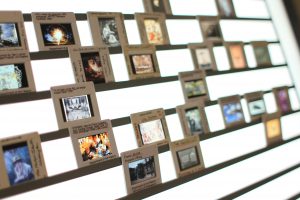December 19, 2017, by Matt Davies
Inspiring Slides: James Malton’s ‘The Custom House, Dublin’ by Niall Walsh.
Today’s Inspiring Slide was chosen by second year History student Niall Walsh who chose James Malton’s The Custom House, Dublin, 1792. Find out how you could be inspired by the School of Humanities’ slide collection at the end of Niall’s blog.
The slide I have chosen to write about depicts a drawing by James Malton, an English architectural draughtsman and artist who had moved to Dublin with his father during his early life. His father, Thomas Malton was of the same profession as James and had quite notably produced the first commercially available pop-up book. James Malton however, is most famous for his series of twenty-five prints published between 1792 and 1799, four years before his death in 1804. One of these prints shows the Dublin Custom House in its prime. Finished in 1792, Malton paints a scene of the Custom House overlooking numerous trading ships, which had brought significant wealth to the city of Dublin.
The decision to build the new Custom House (one built in 1707 was deemed unfit for purpose) was made by John Beresford, First Commissioner of Revenue for Ireland, in 1780. James Gandon was appointed as the architect for the project, with it being his first large scale commission. Malton was hired as Gandon’s draughtsman. The building is of Palladian architectural design, drawing influence from the 16th century Venetian architect, Andrea Palladio. The construction of the Custom House was mired in controversy, with Dublin’s governing body complaining that it would shift the commercial centre of the city to a less desirable location. Various obstacles were put up by the City Council such as delaying the purchasing of necessary land. The disagreement eventually culminated with the City Council organising a mob of several thousands to disrupt the laying of foundations, however, construction was eventually finished. The total cost of the Custom House was £200,000 in 1791 upon its completion, equivalent to roughly £33 million in 2017.
The building’s original use of processing custom duties became obsolete as Dublin’s trade moved further down river. It instead began to be used by the Local Government Board of Ireland. This made it a prime target for the Irish Republican Army during the Irish War of Independence in 1921, during which it was set on fire, destroying much of the original interior. Although succeeding in their aim of burning down the Custom House, it was in reality a defeat for the IRA, with 80 of the 120 volunteers who had undertaken the attack being captured by British Authorities and a further 5 being killed. A battle with the police had included the use of Lewis Machine guns which had been used widely in the previous decade on the Western Front. Other IRA members had delayed dispatched fire engines, so the inferno was unable to be put out, it lasted for five days in total. The IRA later issued a statement saying:
“We in common with the rest of the nation regret the destruction of historical buildings. But the lives of four million people are a more cherished charge than any architectural masterpiece. The Custom House was the seat of an alien tyranny.”
The Custom House was later rebuilt by the newly independent Irish Government during the 1920s. The collapsed dome was rebuilt using Irish Ardbraccan limestone in an attempt to promote the use of Irish resources, a testament to the buildings unique and long lasting link with Ireland’s history. Whereas at the time of Malton painting the Custom House it was closely linked with the British Empire, it would later become intertwined with Irish nationalism and independence.
My research on the particular slide that I chose has further reinforced my belief in the importance of the Digital Humanities Slide collection as a resource. What started as me picking out an interesting looking slide from the drawer vaguely titled, ‘British Art History 27” has given me an insight into Irish history, which I have never studied before.
If you are a member of UoN’s Arts Faculty and would like to enter the Inspiring Slides competition, get your work posted here on Digital Dialogues and maybe even win a prize. Just choose a slide from the collection–any slide will do –and write a response to it. It may be a memory prompted by the slide or an immediate response in the form of a story, poem or even art work, or perhaps an examination or interpretation of the image. Prose need not be long, three or four paragraphs, 500 words is about average.
If you cannot think of a particular image but fancy having a go, there is a selection of slides chosen exclusively by the DHC team on Lightbox one in the DHC. Choose an image, scan (yes we do have a slide scanner in DHC!) or take it away and let your imagination run wild!
Send all entrees to digitalhumanities@nottingham.ac.uk
No comments yet, fill out a comment to be the first


Leave a Reply